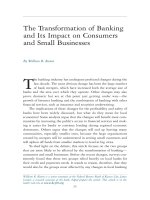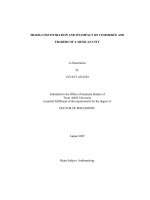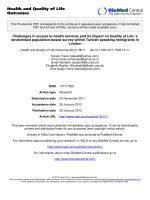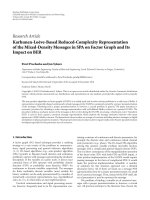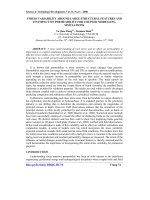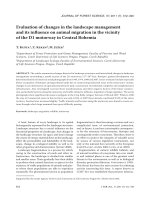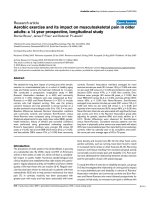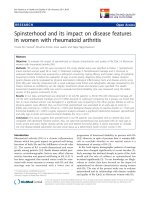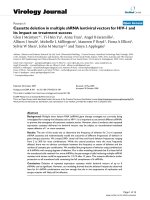Master of Business Administration: The Capital Structure and its impact on firm value of JSE Securities Exchange Listed Companies
Bạn đang xem bản rút gọn của tài liệu. Xem và tải ngay bản đầy đủ của tài liệu tại đây (2 MB, 95 trang )
Thesis for the Master of Management in Finance and Investments
Topic: The Capital Structure and its impact on firm value of JSE Securities Exchange Listed
Companies
Name: Neo Mohohlo
Student number: 693236
Supervisor: Professor Kalu Ojah
Wits Business School
Faculty of Commerce, Law and Management
Wits Business School
2 St. David’s Place, Parktown, Johannesburg 2193
P.O Box 98, Wits 2050, South Africa
Thesis submitted in fulfillment of the requirements for the degree of
MASTER OF MANAGEMENT IN FINANCE AND INVESTMENT
in the
FACULTY OF COMMERCE, LAW AND MANAGEMENT
WITS BUSINESS SCHOOL
at the
UNIVERSITY OF THE WITWATERSRAND
DECLARATION
I, Neo Mohohlo, declare that the research work reported in this dissertation is my own,
except where otherwise indicated and acknowledged. It is submitted to fulfill the
requirements for the Masters of Management in Finance and Investment degree at the
University of the Witwatersrand, Johannesburg. This thesis has not, either in whole or in
part, been submitted for a degree or diploma to any other institution or university for a
similar qualification.
___________________
N.R Mohohlo
27 March 2013
Date
Acknowledgements
I wish to express my gratitude to God almighty for giving me the strength to complete this
thesis. As with most processes the completion of this thesis required input and support
from people other than me. I wish to express a special thanks to the following people:
Prof. Kalu Ojah for his professional supervision, support and guidance.
Niven Pillay for his assistance and valuable support especially with the research topic
and methodology.
Tewodros Gebreselasie for his guidance and support.
Kgosi Rahube for his assistance with the data.
Allan Kundu for his assistance with the regressions.
Indheran Pillay and Natalie Morley for editing and formatting my final paper.
My family and loved ones for their support and understanding.
Abstract
The capital structure theory was pioneered by Modigliani and Miller (1958). In their study,
Modigliani and Miller (1958) argued that capital structure was irrelevant to firm value.
There is also significant theory on the capital structure of firms and its determinants.
Using a panel of non-financial firms listed on the JSE Securities Exchange, we investigate the
relevance of capital structure on firm value and investigate the capital structure of firms in
South Africa. The results of the analysis on the relevance of capital structure on firm value
indicated that there is no statistically significant relationship between firm value and the
capital structure of firms. This analysis was conducted for the general sample of firms in the
study, within industries and by firm size, however, the results were consistent throughout
all the analysis.
The results of the capital structure and its determinants analysis indicated that South
African firms followed a pecking order theory. The results also indicated that profitability,
size, asset tangibility and tax shield has a statistically significant relationship to gearing or
the firm’s capital structure. The analysis of the South African firms’ capital structure
indicated that firms in South Africa tend to use more long-term debt than short-term debt.
The leverage ratios also differed among industries with the Health care industry having the
highest levels of leverage and the Technology industry having the lowest levels of leverage.
Contents
Acknowledgements................................................................................................................................. 3
Abstract ................................................................................................................................................... 4
1
Chapter one - Introduction ............................................................................................................. 1
1.1
Background Literature ............................................................................................................ 1
1.2
Problem Statement ................................................................................................................. 3
1.3
Purpose Statement ................................................................................................................. 3
1.4
Significance of study ............................................................................................................... 4
1.5
Data and Methodology ........................................................................................................... 4
1.5.1
Data ................................................................................................................................. 4
1.5.2
Methodology ................................................................................................................... 5
1.6
2
3
Outline of the Study ................................................................................................................ 5
Chapter two - Literature review ..................................................................................................... 6
2.1
Introduction ............................................................................................................................ 6
2.2
Defining capital structure........................................................................................................ 7
2.3
Defining firm value .................................................................................................................. 8
2.4
Capital structure theories ....................................................................................................... 9
2.4.1
Modigliani and Miller’s capital structure irrelevance ................................................... 10
2.4.2
The trade-off theory...................................................................................................... 11
2.4.3
Pecking order theory..................................................................................................... 16
2.4.4
The market timing theory ............................................................................................. 18
2.5
The capital structure landscape ............................................................................................ 19
2.6
Literature on the effect of capital structure on firm value ................................................... 20
2.7
Conclusion ............................................................................................................................. 24
Chapter three - Research questions and hypotheses ................................................................... 28
3.1
Research hypothesis one: capital structure is irrelevant as per MM1 ................................. 28
3.2
Research hypothesis two: does the debt-to-equity ratio differ among industries listed on
the JSE 28
3.3
Research hypothesis three: is the industry debt-to-equity ratio persistent ........................ 29
3.4
Research hypothesis four: there is a relationship between debt-to-equity ratio and
profitability, size of firm, tax shield and asset tangibility ................................................................. 29
3.5
Research hypothesis five: is there a difference among industries in terms of reliance on
long-term debt .................................................................................................................................. 30
4
5
Chapter four - Research data and methodology .......................................................................... 31
4.1
Introduction .......................................................................................................................... 31
4.2
Population of analysis ........................................................................................................... 31
4.3
Unit of study.......................................................................................................................... 31
4.4
Sampling technique .............................................................................................................. 31
4.5
Data collection ...................................................................................................................... 32
4.6
Data analysis ......................................................................................................................... 32
4.6.1
Descriptive statistics ..................................................................................................... 32
4.6.2
Regression analysis ....................................................................................................... 33
4.6.3
Defining the dependent variables................................................................................. 35
4.6.4
Defining the explanatory variables ............................................................................... 35
4.6.5
Hypothesis testing process ........................................................................................... 36
Chapter five - Presentation and analysis of results ...................................................................... 37
5.1
Introduction .......................................................................................................................... 37
5.1.1
Descriptive statistics ..................................................................................................... 37
5.1.2
Unit root test ................................................................................................................. 38
5.2
Research hypothesis one: capital structure is irrelevant as per MM1 ................................. 39
5.2.1
The irrelevance of capital structure in some of the industries sampled in the study .. 39
5.2.2
Summary of results ....................................................................................................... 45
5.3
Research hypothesis two: does the debt-to-equity ratio differ among industries listed on
the JSE 52
5.4
Research hypothesis three: is the industry debt-to-equity ratio persistent ........................ 52
5.4.1
Results presentation ..................................................................................................... 53
.......................................................................................................................................................... 53
5.4.2
Summary of results ....................................................................................................... 57
5.5
Research hypothesis four: there is a relationship between debt-to-equity ratio and
profitability, size, asset tangibility and tax shield ............................................................................. 58
5.5.1
The variables that affect the capital structure of some of the industries sampled in
this study 58
5.5.2
Summary of results ....................................................................................................... 63
5.6
Research hypothesis five: is there a difference among industries in terms of reliance on
long-term debt .................................................................................................................................. 64
6
5.6.1
Results presentation ..................................................................................................... 65
5.6.2
Summary of results ....................................................................................................... 69
Chapter six – Summary of the findings and Conclusion ............................................................... 70
6.1
Introduction .......................................................................................................................... 70
6.2
Summary of findings ............................................................................................................. 70
6.3
Conclusion ............................................................................................................................. 72
References ............................................................................................................................................ 73
Appendix A ............................................................................................................................................ 79
Appendix B ............................................................................................................................................ 87
Tables
Table 1: ALL INDUSTRIES POOLED – DESCRIPTIVE STATISTICS ............................................................. 38
Table 2: UNIT ROOT TEST ...................................................................................................................... 38
Table 3: FEM REGRESSION OF ALL COMPANIES - FIRM VALUE AS DEPENDENT .................................. 39
Table 4: FEM REGRESSION OF INDUSTRIAL COMPANIES - FIRM VALUE AS DEPENDENT..................... 40
Table 5: FEM REGRESSION OF BASIC MATERIALS COMPANIES - FIRM VALUE AS DEPENDENT ........... 41
Table 6: FEM REGRESSION OF CONSUMER SERVICES COMPANIES - FIRM VALUE AS DEPENDENT ..... 42
Table 7: FEM REGRESSION OF CONSUMER GOODS COMPANIES - FIRM VALUE AS DEPENDENT ........ 43
Table 8: FEM REGRESSION OF HEALTH CARE COMPANIES - FIRM VALUE AS DEPENDENT .................. 44
Table 9: FEM REGRESSION OF TECHNOLOGY COMPANIES - FIRM VALUE AS DEPENDENT.................. 45
Table 10: UNIT ROOT TEST (RE-SPECIFIED MODEL) .............................................................................. 47
Table 11: FEM REGRESSION OF ALL COMPANIES - FIRM VALUE AS DEPENDENT ................................ 48
Table 12: FEM REGRESSION OF LARGE FIRMS - FIRM VALUE AS DEPENDENT ..................................... 49
Table 13: FEM REGRESSION OF MEDIUM FIRMS - FIRM VALUE AS DEPENDENT ................................. 50
Table 14: FEM REGRESSION OF SMALL FIRMS - FIRM VALUE AS DEPENDENT ..................................... 51
Table 15: DEBT-TO-EQUITY RATIOS BY INDUSTRY ................................................................................ 52
Table 16: FEM REGRESSION OF ALL COMPANIES AND INDUSTRIES - CAPITAL STRUCTURE AS
DEPENDENT........................................................................................................................................... 58
Table 17: FEM REGRESSION OF INDUSTRIALS COMPANIES - CAPITAL STRUCTURE AS DEPENDENT ... 59
Table 18: FEM REGRESSION OF BASIC MATERIALS COMPANIES - CAPITAL STRUCTURE AS DEPENDENT
.............................................................................................................................................................. 60
Table 19: FEM REGRESSION OF CONSUMER SERVICES COMPANIES - CAPITAL STRUCTURE AS
DEPENDENT........................................................................................................................................... 61
Table 20: FEM REGRESSION OF CONSUMER GOODS COMPANIES - CAPITAL STRUCTURE AS
DEPENDENT........................................................................................................................................... 62
Table 21: FEM REGRESSION OF HEALTH CARE COMPANIES - CAPITAL STRUCTURE AS DEPENDENT .. 63
1 Chapter one - Introduction
1.1 Background Literature
There is a considerable number of theories and research on the effect of capital structure on
firm value, size and profitability. The capital structure of the firm refers to the sources of
funding used to finance a firm’s investments. This refers to the choice between equity
financing and debt financing. According to Modigliani and Miller (1958), the value of the
firm, that is, its stock price, does not depend on the capital structure of the firm. This
theory by Modigliani and Miller is based on a set of simplifying assumptions. These
assumptions include no taxes, no transaction costs and no information asymmetry. The
theory says that the total market value of all financial assets issued by a firm is determined
by the risk and return of the firm’s real assets, not by the mix of issued securities (Byström,
2007).
The main idea behind Modigliani and Miller’s theory is that a rational investor can create
any capital structure on his/her own. Therefore, the firm should not focus much on its
capital structure. “If the investor is highly indebted, the risk and return of the firm’s stock
(to the investor) will simply be the same as if the firm was highly levered” (Byström, 2007).
This substitution called homemade leverage and the finding that a more leveraged firm
doesn’t only yield higher returns to the investor but also a higher risk, is the crux of
Modigliani and Miller’s theory.
There is a theory that states the value of the firm, in a world with corporate taxes, is
positively related to its debt. This theory, which is known as the trade-off theory, states that
profitable firms will tend to use more debt in order to capture the tax shield offered by debt
financing of investments. According to this theory, in an all-equity firm, only shareholders
and tax authorities have claims on the firm. The value of the firm is owned by the
shareholders and the portion going to taxes is just a cost. The value of the levered firm has
three claimants, namely: the shareholders, debt holders and tax recipients (Government).
Therefore, the value of the levered firm is the sum of the value of the debt and the value of
the equity. In these instances, value is maximised with the structure paying the least in the
form of taxes (Hillier, et al., 2010).
1
Other theories on capital structure include the pecking order theory and the market timing
theory. According to the pecking order theory firms prefer internal finance and if external
finance is required, firms issue the safest security first. That is, they start with debt, then
possibly hybrid securities then equity as a last resort (Myers, 1984). This assumes that a
firm’s debt ratio will be reflective of its cumulative requirements for external finance. In
contrast to the trade -off and pecking order theories of capital structure, Baker and Wurgler
(2002) found that firms with low levels of leverage raised capital when their market
valuations were high as measured by the market-to -book ratio whereas firms with high
levels of leverage raised capital when their market valuations were low. This theory is
known as the market timing capital structure theory.
According to research by Kurshev and Strebulaev (2005), it has been established that large
firms in the United States tend to have higher leverage ratios than smaller firms.
International evidence suggests that in most, though not all countries, leverage is also crosssectionally positively related to size. Intuitively, firm size should be relevant or related to
leverage for a number of reasons. Firstly, in the presence of fixed costs of raising external
funds, large firms have cheaper access to outside financing. Also large firms are more likely
to diversify their sources of financing. Secondly, size may also be a proxy for the probability
of default because it is often assumed that it is more difficult for larger firms to fail or
liquidate. Firm size may also be a proxy for the volatility of firm assets because small firms
are more likely to be growing firms in industries that are rapidly expanding and intrinsically
volatile. Another reason for the significance of firm size is the extent of the wedge in the
degree of information asymmetry between insiders and the capital markets which have a
tendency to prefer larger firms by virtue of a greater scrutiny they face from the ever –
suspicious investors (Kurshev and Strebulaev, 2005).
Gwatidzo and Ojah (2009), one of the most encompassing studies that have been conducted
on African markets including South Africa, found that companies in these markets tend to
follow a modified pecking order. Their study looked at five African markets (Ghana, Kenya,
Nigeria, South Africa and Zimbabwe) collectively. In their study, Gwatidzo and Ojah (2009)
tested for capital structure dependence on variables such as asset tangibility, corporate tax,
profitability, size and firm age. In terms of Gwatidzo and Ojah’s (2009) finding, is that what
happens in South Africa which has sophisticated institutional and physical capital markets
2
infrastructure? Is the legal environment encompassing clearly stated and enforced laws?
Are the courts effective in forcing borrowers to honour business contracts?
1.2 Problem Statement
How well do firms in South Africa understand the dominant capital structure in their sector
and general economy? The problem is that not knowing the average cost of external funds
will lead firms to make inadequately informed capital budgeting decisions. For a firm to
grow it has to embark on value adding projects; hence effective capital budgeting is
indispensable.
One of the ways for enhancing the effectiveness of the capital budgeting process is to
estimate cash flows from the projects and the cost of capital. If a company does not have a
good sense of what the dominant capital structure is in the market, it will not have a good
sense of what the appropriate cost of external capital should be, whether debt or equity.
Even though there have been many studies on capital structure, the bulk of these studies
focused on developed capital markets. The literature on capital structure and its effect on
firm value is still very thin in the African context.
1.3 Purpose Statement
Apart from trying to shed sufficient light on the dominant capital structure in South Africa,
this study attempts to answer the question of: what is the role of capital structure in firm
valuation? In addition, the role of other market and economic variables like taxation will be
assessed using a regression model and data drawn from financial markets.
To date, Gwatidzo and Ojah (2009) conducted one of the few most comprehensive studies
in Africa on capital structure. This study is therefore intended to build upon the work that
has been conducted so far and to contribute to the body of literature with the following
questions as guidelines:
Is capital structure irrelevant as per MM I?
What is the capital structure (debt-to-equity) of firms per industry in South Africa?
How persistent is the equity-debt capital structure?
What factors determine the equity-debt structure divide?
What is the debt structure in terms of funding between long term and short term
debt?
3
How persistent is the long term-short term structure?
1.4 Significance of study
Limited research exists on the capital structure of firms in Africa, as a result we know little
about how these firms make capital structure decisions (Gwatidzo and Ojah, 2009).It is,
therefore, necessary to deliberate on the capital structure of firms in Africa.
Firms in Africa operate within a different environment as compared with firms in developed
countries mainly due to the differences in institutional infrastructure. Capital markets in
Africa are characterised by inefficiency, they are small and thinly traded (Singh, 1999). In
contrast, capital markets in developed economies are characterised by well-functioning and
efficient stock markets and well developed credit markets. It is therefore inappropriate to
claim that the findings that come out of studies done on developed economies apply to
developing economies such as the African market.
This research may prove useful in filling the research gap that exists in the literature and
increase our understanding of the capital decisions taken by firms in South Africa.
1.5 Data and Methodology
1.5.1 Data
The research analysis will be carried out on the firms listed on the JSE Securities Exchange
(JSE), excluding financial firms. Financial firms are excluded because their capital structure
is different from that of non-financial firms, as their capital structure, sources and allocation
of funds are dictated by regulations including mainly the capital adequacy ratio and reserve
requirement. The distinction between the deposit type debt and the outright debt of
financial firms is blurred, which also makes the capital structure of these firms difficult to
distinguish. The study will focus on listed firms because of the availability of data as listed
firms have several data sources above and beyond their financial reports. The data that will
be used for the analysis will be largely financial data, drawn mainly from the Bloomberg
database. Bloomberg is the preferred source of the required financial data relating to the
firms on the JSE because it is a relatively all-encompassing data base of global information,
however, McGregorBFA was also used as a source of data. The financial data compiled and
used for the analysis will be in panel data form.
4
1.5.2 Methodology
Regression analysis will be used in answering the research questions. “Regression analysis is
a statistical tool for the investigation of relationships between variables [whereby]… the
investigator assembles data on the underlying variables of interest and employs regression
to estimate the quantitative effects of the causal variables upon the variable that they
influence” (Sykes, 2003). The data collected on the JSE listed firms will be analysed using
econometric techniques and a tool pack called E-views. Relevant economic theories and
empirical studies will be examined in order to build the most appropriate structure for
assessing the hypothesized relationships.
1.6 Outline of the Study
The outline of the research paper will be as follows. Section 2 will elaborate the relevant
literature. Section 3 will detail the research questions and hypothesis. Section 4 will
outline the methodology in detail, elaborating on the data, techniques employed and the
model. Section 5 will contain the presentation and analysis of the results from the empirical
analysis and Section 6 will draw conclusions on the findings of the research or make
inferences for possible future research.
5
2 Chapter two - Literature review
2.1 Introduction
Capital structure decisions can have important implications for the value of the firm and its
cost of capital (Firer et al, 2008). Inadequate capital structure decisions can lead to a large
cost of capital thereby lowering the net present value (NPV) of the firm’s investment
projects making the investment projects unacceptable i.e the underinvestment problem.
Efficient capital structure decisions will lower the firm’s cost of capital and increase the NPV
of the firm’s investment projects leading to more projects being suitable to accept thereby
increasing the value of the firm.
Capital structure is a very significant decision for firms to make so that they can maximize
returns to their various stakeholders. Furthermore the correct capital structure is important
to the firm as it will aid in dealing with the competitive environment within which the firm
operates. According to Modigliani and Miller (1958) an ‘optimal’ capital structure exists
when the risks of going bankrupt is offset by the tax savings of debt. When this optimal
capital structure is realised, a firm would be able to maximise returns to its stakeholders
that are higher than returns that would be attained from a firm whose capital consists of
equity only i.e an all equity firm.
Despite the importance that capital structure can play in adding value to the firm, decades
worth of theoretical literature and empirical testing have not been able to give guidance to
practitioners with regards to the choice between debt and equity in their capital structures
(Frank & Goyal, 2009). It is rather baffling to try to logically understand capital structure
literature because different capital structure theories are frequently utterly opposed in their
predictions while sometimes they may be in agreement but have opposing views about why
the outcome has been predicted. It is for this reason that Myers (2001) stated that there is
no universal theory of capital structure, only conditional ones.
Factors that are of
significance in one context may be of substantial insignificance in another.
There is a number of theories relating to the capital structure and its effect on firm value
and its performance. Modigliani and Miller (1958) were the leading authors to landmark the
topic of capital structure and they argued that capital structure was irrelevant in
determining the value of the firm and its future performance. Many other studies including,
6
Lubatkin and Chatterjee (1994) have argued that there exists a relationship between capital
structure and firm value.
In more recent studies, authors have displayed that they are less concerned about how
capital structure affects the firm value. They, however, place more emphasis on how capital
structure
impacts
the
ownership/governance
structure
thereby
influencing
top
management of the firms to make strategic decisions (Hitt, Hoskisson & Harrison, 1991).
These decisions will in turn impact on the overall performance of the firm (Jensen, 1986).
2.2 Defining capital structure
The notion of financial management can be defined as a managerial activity, which is highly
concerned about controlling and planning of firm’s financial resources, (Pandey & Bhat,
2007). Furthermore, the functions of finance encompass a diverse area. These functions
comprise choices on investments, choices on financing, choices on dividends, and choices on
liquidity. This paper encompasses aspects with respects to the financing decision of a
company i.e deciding on how to obtain funds in order to fulfil the firm’s needs of
investments.
The study of capital structure centres around the mix between debt, equity and the range of
other hybrid instruments used to finance the investments of the firm. Capital structure is
therefore concerned with the right hand side of the balance sheet (Myers, 2002). All items
on the right hand side of the balance sheet, excluding current liabilities, are sources of
capital employed to finance the real assets required to conduct the business of the firm
(Dreyer, 2009). Below is a simplified graphical depiction of the capital structure.
7
Retained
profit
Fixed assets
Equity
Equity
capital
Net assets
Capital
Overdraft
Working capital
Loans
Long-term
loans
Figure 1: APPLICATION AND SOURCES OF FUNDING (An adoption from Ward & Price, 2006
pgs. 24 - 24)
The equity holders are the owners of the firm and bear most of the risk associated with the
business venture since they normally only have a residual claim to the assets of the firm
(Dreyer, 2009).
According to Gitman (2003) equity holders are rewarded for their
investment primarily through the appreciation of the value of their common equity and in
some instances through the receipt of dividends.
Debt holders are compensated through interest payments and usually insist on some form
of collateral as security for the loans they provide. Debt holders may also protect their
interest through the establishment of loan covenants. They also have first claim on the
assets of a firm and bear less risk than the equity holders. Debt is therefore a generally
cheaper funding option to equity (Gitman, 2003).
If you want to evaluate the performance of the firm it is important to consider all interest
bearing borrowings as loan capital regardless of whether they are short term or long term
loans (Ward & Price, 2008). Firms manage their capital structure by issuing new debt and
equity and by settling old debt or repurchasing issued shares.
2.3 Defining firm value
It is frequently stated that the goal of financial management is to maximise the wealth of
the shareholders or owners of the firm. According to Firer et al (2008) the goal of financial
management is to maximise the current value per share of the existing shares. However,
8
owners only have a residual claim to the assets of the firm and are only paid once every
other stakeholder with a legitimate claim to the firm’s assets has been paid. Since the
lenders, employees and suppliers all have a superior claim on the firm’s assets, it stands to
reason that if the owners’ wealth is maximised then all the other claimants will stand to
gain.
It ought to be noted that profit maximisation and wealth maximisation are not synonymous
terms. A firm can engage in a variety of activities that may increase short-term profit that
are either not translated into cash flows like selling to customers with a low probability of
paying or engaging in other activities which are not profitable and sustainable.
The timing and magnitude of cash flows and their associated risk are therefore the key
drivers of the firms share price and the wealth maximisation of the owners of the firm (Firer
et al, 2008).
To attain the goal of shareholder wealth maximisation, financial managers are confronted
with two imperative financial decisions, the investment and financing decisions.
The
investment decision or capital budgeting is the process of planning and managing a firm’s
long-term investments and identifying investment opportunities that are worth more to the
firm than they cost to acquire (Firer et al, 2008). The financing decision or capital structure
decision refers to the specific mixture of long-term debt and equity the firm uses to finance
its operations (Firer et al, 2008).
The financing decision, therefore, compels the financial manager to decide on whether to
fund projects that the firm undertakes through retained earnings, debt or equity or other
hybrid funding instruments. The funding mixture chosen will affect both the risk and value
of the firm (Firer et al, 2008).
2.4 Capital structure theories
There are a number of capital structure theories but for the purposes of this study we will
review only the three most prevalent theories, the trade-off theory, the pecking order
theory and the market timing theory.
To start off the section we will look at the Modigliani and Miller (1958) theory of capital
structure irrelevance.
9
2.4.1 Modigliani and Miller’s capital structure irrelevance
The departure point for virtually all discussions on capital structure theory is Modigliani and
Miller’s capital structure irrelevance theory first published in 1958 (Dreyer, 2010).
According to Modigliani and Miller (1958) financing doesn’t matter in perfect capital
markets. The value of the firm is maximised by the quality and productivity of the assets in
which the firm has invested.
Consider the market-value balance sheet below:
Figure 2: MARKET-VALUE BALANCE SHEET (Myers, 2001 pg.85)
The market values of the firm's debt and equity, D and E, add up to total firm value V and
Modigliani and Miller's (1958) Proposition 1 says that V is a constant, regardless of the
proportions of D and E, provided that the assets and growth opportunities on the left-hand
side of the balance sheet are held constant (Myers, 2001).
The Modigliani and Miller’s (1958) Proposition 1 as captured in the equation below also
states that (Firer et al, 2008):
Where:
VL= the value of the levered firm
VU= the value of the unlevered firm
10
The expression above states that the value of the levered firm (VL) is equal to the value of
the unlevered firm (VU) (Firer et al, 2008).
According to Firer et al (2008) this implies that:
A firm’s capital structure is irrelevant.
A firm’s weighted average cost of capital (WACC) is the same no matter what
mixture of debt and equity is used to finance the firm.
It is of importance to note that this capital structure irrelevance theory by Modigliani and
Miller only holds under the assumption of perfect capital markets. These perfect capital
markets are defined by Modigliani and Miller as follows:
Homogeneous shares of different firms which are perfect substitutes of each other
All shares being traded under the perfect capital market conditions
Known expected future returns on all shares by investors
Irrespective of the issuer the cost of debt is the same
In concluding their seminal paper Modigliani and Miller (1958) stated that these and other
drastic simplifications had been necessary in order to come to grips with the capital
structure problem, and having served their purpose they could now be relaxed in the
direction of greater realism and relevance.
2.4.2 The trade-off theory
Modigliani and Miller (1963) delivered a correction of their 1958 seminal paper and stated
that “The deduction of interest in computing taxable corporate profits will prevent the
arbitrage process from making the value of all firms in a given class proportional to the
expected returns generated by their physical assets” (Modigliani & Miller, 1963).
The correction restated the Proposition 1 equation to be expressed as (Firer et al, 2008):
Where:
VL= the value of the levered firm
VU= the value of the unlevered firm
11
TC= the corporate tax rate
D = the amount of debt
The above expression states that the value of the levered firm (V L) is equal to the value of
the unlevered firm (VU) plus the present value of the interest tax shield (Firer et al, 2008).
The principal value of debt is the fact that interest payments earned on the repayment of
debt is deductible from corporate income tax. Debt, however, does have shortcomings that
include an increased probability of bankruptcy if the firm failed to service its obligations, the
agency costs earned by the lender to monitor the activities of the firm and the fact that
managers have better prospects of the firm than the investors do (Gitman, 2003).
The trade-off theory rationalises reasonable debt ratios. It says that the firm will borrow up
to the point where the marginal value of tax shields on additional debt is just offset by the
increase in the present value of possible costs of financial distress (Myers, 2001). According
to Fama and French (2005) this optimal capital structure is attained when the marginal
benefit of an extra unit of debt is offset by the marginal cost of an extra unit of debt.
Meyers (2001) also states that, a value-maximizing firm should never pass up interest tax
shields when the probability of financial distress is remotely low. As according to Gitman
(2003) it is widely accepted that the value of the firm is maximised when its cost of capital is
minimised.
Below is a modified zero growth dividend model used to determine the value of the firm
(Gitman, 2003):
Where:
V = the value of the firm
EBIT= earnings before interest and taxes
T = tax rate
EBIT x (1-T) = after tax operating earnings available to debt and equity holders
Ka = weighted average cost of capital (WACC)
12
It can be concluded from the expression above that if the earnings of the firm (EBIT) are
held constant, the value of the firm (V) will be maximised when the average cost of capital
(Ka) is minimised (Dreyer, 2010).
2.4.2.1 The advantages of debt
Debt has a number of advantages for shareholder wealth maximisation some of which are
discussed below:
2.4.2.1.1 Interest tax shield
Because interest payments can be deducted from the basic corporate profits tax but not
dividends, it lowers the expected tax liability to add debt to a firm’s capital structure and
thereby increases its after-tax cash flow (Barclay & Smith, 2005). According to Opler et al
(1997) the value of the tax shield provided by debt in a given year is a function of the
interest amount paid by the firm and its marginal tax rate. For a firm that expects increased
future earnings it is advisable to consider taking on more debt in order to shield earnings
from taxes.
2.4.2.1.2 Reduced agency costs
In the simple form of the agency cost problem, financial managers may not act in the best
interest of shareholders particularly when excessive free cash flows are present electing to
spend cash on things like corporate empire building, perks, making overpriced acquisitions
or simply failing to operate efficiently (Dreyer, 2010). For the cases discussed above both
debt and the payment of dividends can be used as ways of disciplining managers (Graham &
Harvey, 2001).
2.4.2.1.3 Controlling overinvestment
Lowered levels of debt can lead to overinvestment. Overinvestment is a phenomenon that
occurs when the operating cash flow is not reinvested profitably within the firm by financial
managers. This may be as a result of unprofitably investing in the firm’s core businesses, or
worse, diversifying by acquiring unfamiliar business.
Debt can provide an effective solution to this phenomenon through contractually obliged
interest and principal payments which squeezes out excess capital (Barclay & Smith, 2005).
This could also be achieved through paying out the excess free cash to shareholders as a
dividend and incurring debt to fund the capital projects of the firm. Debt can also force
13
financial managers to be more thorough when evaluating the firm’s capital plans and their
implications before they undertake them.
2.4.2.2 The disadvantages of debt
Debt has a number of disadvantages for shareholder wealth maximisation some of which
are discussed below:
2.4.2.2.1 The cost of financial distress
Interest tax deductibility of debt is one of the main propositions made by the trade-off
theory. However, if the firm had to undergo a period of operating at reduced levels of
profitability the value of the interest tax shield will be reduced to zero. The burden of the
interest expense will in this case only serve increase the financial distress experienced by
the firm (Dreyer, 2010).
2.4.2.2.2 Agency costs
Agency costs can be defined as costs that arise due to conflict of interest and this conflict of
interest can be between the shareholders and managers of a firm or between the debt
holders and equity holders of a firm (Harris & Raviv, 1991).
Manager- Shareholder: Ryen et al (1997) state that the two main areas of managershareholder conflict arise when managers fail to best represent the interests of
shareholders through underleveraging thereby forgoing substantial shareholder value and
overspending. This unwillingness by managers to leverage the firm to its optimal levels may
be due to the fact that more debt would increase the total risk of the firm.
Equity holder-Debtholder: There is a number of ways in which equityholders can increase
their wealth through the exploitation of debtholders after a bond issue. This could be done
through underinvestment which entails rejecting positive NPV projects if their benefits
accrue only to debtholders, issuing new debt that is of a higher priority than the existing
debt, floating debt for low risk projects and using the free cash for high risk projects, and at
the extreme, through an increased dividend rate risk the chance of liquidating the firm.
In such instances, debtholders can protect themselves through the inclusion of covenants in
their debt agreements. These covenants can, however, lead to problems with production,
underinvestment and the financing of the firm (Ryen et al, 1997).
14
2.4.2.2.3 Underinvestment
According to Barclay and Smith (2005)even in situations that are less extreme than
bankruptcy, highly leveraged firms are more likely than their less leveraged counterparts to
forgo valuable investment opportunities when faced with the prospect of the inability to
service their financial obligations. This underinvestment problem can be heightened by the
conflict that can arise among the other claimants of the firm such as shareholders who may
feel that their investment will be directed towards restoring the financial position of the
firm’s bondholders instead of creating wealth for them within the firm. In this instance, the
cost of the new equity could be so excessive that managers might rationally forgo both the
capital plans and the investment opportunities (Myers, 1997; Barclay & Smith, 2005).
Ryen et al (1997) also observed that besides passing up positive net present value (NPV)
projects that would maximise the value of the firm, managers would forgo investing
adequate effort in developing and maintaining company-specific human capital.
2.4.2.3 The dynamic trade-off theory
In the traditional/static trade-off theory firms select a target leverage level by weighting the
benefits (which include the tax deductibility of interest and the reduction of the free cash
flow problem) and costs (which include the expected financial distress costs and the costs
arising from the agency conflict between shareholders and bondholders) of an additional
unit of debt (Ovtchinnikov, 2010). Below is a graphical illustration of the static trade-off
theory.
Figure 3: THE STATIC TRADE-OFF THEORY OF CAPITAL STRUCTURE (Myers, 1984 pg.577)
15
Unlike the static trade-off theory, which implicitly assumes that firms always stay at target
leverage by continuously adjusting leverage to the target, the dynamic version recognizes
that financing frictions make it suboptimal for firms to continuously adjust leverage to the
target. Under the dynamic trade-off theory, firms weigh the benefit of adjusting against the
adjustment cost and make leverage adjustments only when the benefit outweighs the cost
(Ovtchinnikov, 2010).
The above implies that should the market conditions become adverse, a firm may spend
some time away from its target capital structure and only return back to them when
conditions are favourable. The level of speed at which a firm reverts back to its target
capital structure will depend on whether the firm is above or below the target leverage
ratio. This may be due to the fact that, when a firm operates at a level of debt significantly
above the industry mean, the cost of financial distress increases markedly and rebalancing
the capital structure becomes a significantly more meaningful task (Cai & Ghosh, 2003).
According to Myers (1984) the explanation of the dynamic trade-off theory regarding
frictions that prevent firms from remaining at or near their target capital structure is not
fully satisfactory as it is not stated to be of first order concern in the static trade-off theory.
Costs cannot be so large that they could force managers to take lengthy deviations from
their target levels of optimal capital structure, greater analysis should be spent on
understanding and explaining these frictions rather than refining the static trade-off theory
(Myers, 1984).
2.4.3 Pecking order theory
In the pecking order theory there is no well-defined target of the debt-equity mix, because
there are two kinds of equity, internal and external, one at the top of the pecking order and
one at the bottom for each firm's observed debt ratio reflects its cumulative requirements
for external finance(Myers, 1984). The pecking order arises if the costs of issuing risky
securities such as transactions costs and the costs created by management’s superior
information about the value of the firm’s risky securities overwhelm the costs and benefits
proposed by the trade-off model (Fama & French, 2005).
16
According to the pecking order theory, firms will first finance new investments with retained
earnings, then with safe debt, then risky debt and finally, but only under duress, with
outside equity in order to lessen adverse selection costs (Fama & French, 2005). Below is a
graphical illustration of the pecking order theory.
Figure 4: THE FINANCING HIERACHY OF THE PECKING ORDER (Leary & Roberts, 2010
pg.334)
Although the pecking order theory is based on the adverse selection based on information
asymmetry, it has been proven that information asymmetry does not need to exist for a
financing hierarchy to arise. It has, however, been shown that other factors such as
incentive conflicts could generate a pecking order behaviour (Leary & Roberts, 2010).
Titman and Wessels (1988) also found that transaction costs may also be an important
factor in the pecking order behaviour and this is substantiated by the fact that short-term
debt ratios are negatively related to firm size. This variance in financing practice probably
reflects the high transaction costs that small firms face when they issue long-term debt or
equity (Titman & Wessels, 1988).
It is usually thought of the cost of external finance as that of administration and
underwriting and in other cases the under-pricing of new securities, however, asymmetric
information creates the possibility of costs related to rejecting positive net present value
(NPV) projects. One such incentive cost could be the reflection on the shareholders of a
17
firm that the managers are not adequately representing the interest of the shareholders
through their excessive risk averse. Managers may on the other hand feel that they have
more information on the cost and benefits of debt than shareholders when choosing to pass
up on new investment opportunities when the earnings of the firm or investment project
are volatile (Lewellen, 2006).
Although a firm might have initiated a pecking order, it may sometimes choose to not follow
the pecking order so that it can maintain a spare debt capacity or hold internal earnings in
favour of debt if it is believed that it will be essential to fund profitable future investment
opportunities (Ryen et al, 1997).
The other reason why firms might choose to maintain a spare debt capacity would be to
maintain their credit ratings. Spare debt capacity also enhances the firm’s ability to endure
periods of poor performance and allows for the execution of a recovery plan (Shivdasani &
Zenner, 2005).
2.4.4 The market timing theory
Equity market timing refers to the practice of issuing shares at a high price (when their
valuations are higher relative to book value and past market valuations) and repurchasing
them at low prices (when their market valuations are lower). As a result observed capital
structures are a function of the past market valuations of securities instead of a desire to
attain an optimum capital structure or as a consequence of following a pecking order (Baker
& Wurgler, 2002).
According to Baker and Wurgler (2002) four outcomes of their empirical studies support
their market timing hypothesis, and they are as follows:
An analysis of past financing decisions show that firms tend to issue equity instead of
debt when their share price is higher relative to the book value and previous market
values and they tend to repurchase the shares when their current market values are
lower than past values
Analyses of long-run stock returns following corporate finance decisions suggest that
timing the equity market is successful for firms on average (Dreyer, 2010)
Earnings forecasts and realisations around equity issues suggest that firms issue equity
where there is investor market optimism about future earnings prospects (Dreyer, 2010)
18
